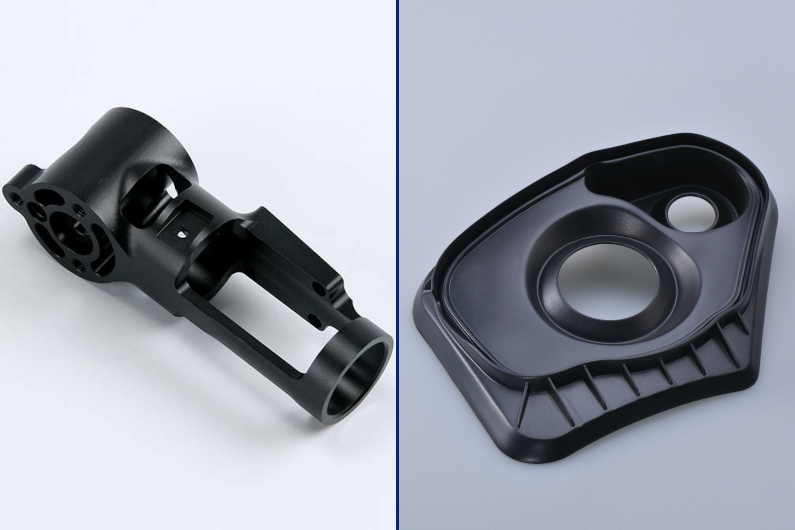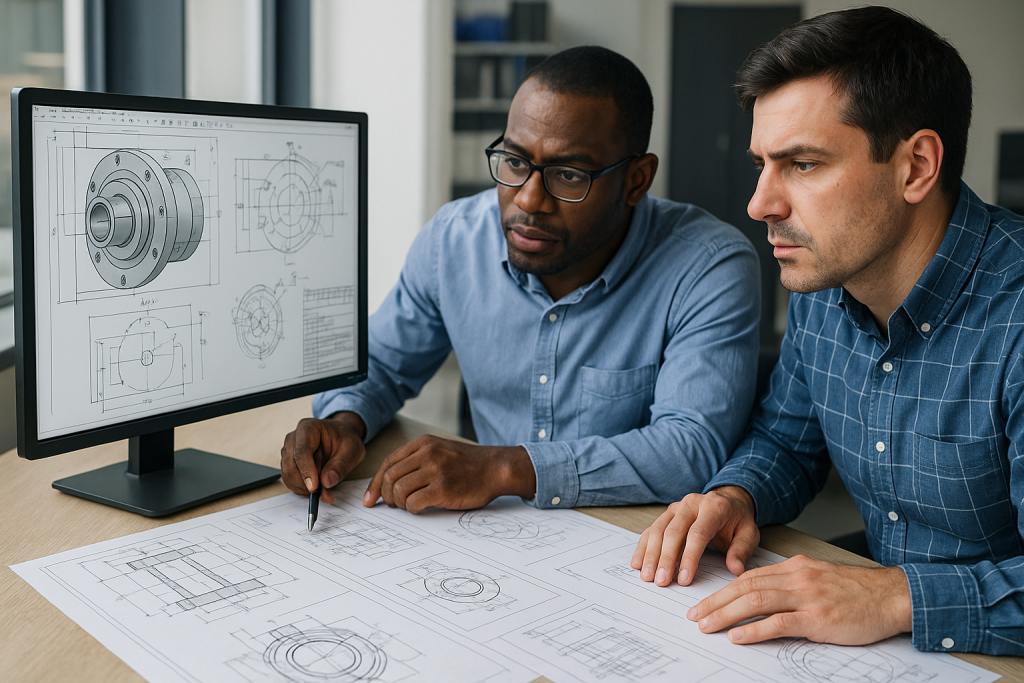The electric vehicle (EV) industry demands precision, high performance, and cost-efficiency for its components. Choosing the right manufacturing process—injection molding or CNC machining—can significantly impact the quality, cost, and time-to-market of your EV parts. This article explores the strengths and limitations of both methods and offers guidance on when to use each, with insights and services from Boona Prototypes.
I. CNC Machining for EV Components
CNC machining is a subtractive manufacturing process that uses computer-controlled tools to shape materials with high precision. At Boona Prototypes, CNC machining specializes in producing metal and plastic parts for EV applications, including battery housings, motor components, and cooling plates.
Strengths of CNC Machining:
-
High Precision: CNC can achieve tolerances as tight as ±0.01 mm, essential for critical parts such as battery modules and motor shafts (Boona CNC Machining Service).
-
Material Versatility: Metals like aluminum, copper, steel, and engineering plastics can be machined (Boona Prototypes).
-
Rapid Prototyping: Ideal for low to medium volume and design iteration, CNC parts can be delivered within 3 working days.
Limitations:
-
Higher per-unit cost compared to molding for mass production.
-
Material waste due to the subtractive nature of machining.
-
Less efficient for very large production runs.
II. Injection Molding for EV Parts
Injection molding is a molding process where molten plastic is injected into a mold to form parts. Boona Prototypes offers full-service plastic injection molding, including mold design, tooling, and production, suitable for producing enclosures, connectors, and other plastic EV components.
Strengths of Injection Molding:
-
Cost-effective for High Volume: Once tooling is complete, per-unit costs are very low.
-
Consistent Quality: Produces repeatable parts with fine details and complex geometries.
-
Material Efficiency: Minimal waste with regrindable sprues and runners.
Limitations:
-
High initial tooling cost and longer lead time (around 7 days for tooling at Boona).
-
Limited to plastics and elastomers.
-
Design changes after tooling are costly.
III. When to Use CNC vs. Injection Molding for EV Parts
| Criteria | CNC Machining | Injection Molding |
|---|---|---|
| Volume | Low to medium volume, prototyping | High volume production |
| Material | Metals (Al, Cu, Steel), engineering plastics | Thermoplastics, silicone, elastomers |
| Precision | ±0.01 mm or better, complex shapes | Consistent plastic parts, less suited for metal parts |
| Setup Cost & Lead Time | Lower setup cost, fast turnaround (3 days typical) | High tooling cost, longer lead time (~7 days tooling) |
| Design Flexibility | High; easy to iterate and change | Low; design locked after mold creation |
| Waste | More waste due to cutting | Minimal; recyclable waste materials |
IV. Application Examples in EV Industry
-
Battery Modules: CNC machining is preferred for aluminum battery housings and cooling plates requiring micron-level precision (Boona Prototypes Battery Parts).
-
Plastic Enclosures & Connectors: Injection molding is ideal for producing large quantities of plastic casings and connectors (Boona Injection Molding Service).
V. Cost & Time Comparison Table
| Parameter | CNC Machining | Injection Molding |
|---|---|---|
| Typical Lead Time | 3–7 days | 7–21 days (tooling + production) |
| Setup Cost | Low ($100s–$1000s) | High ($5,000+) |
| Per Unit Cost (Low Volume) | High ($50+) | Very High (not cost-effective) |
| Per Unit Cost (High Volume) | Moderate ($10–$20) | Low (< $1–$5) |
| Material Waste | High (chips, scrap) | Low (regrindable runners) |
| Material Types | Metals + plastics | Mostly plastics |
VI. Hybrid Manufacturing Strategy
Many EV manufacturers adopt a hybrid approach:
-
Start with CNC machining for fast prototyping and testing.
-
Transition to injection molding for mass production of finalized plastic components.
-
Use CNC machining for mold tooling and post-molding finishing (Boona Prototypes Mold Tooling).
Conclusion
Selecting between CNC machining and injection molding for EV parts depends largely on volume, material, precision, and budget. For metal components and prototypes, CNC machining from Boona Prototypes offers unmatched accuracy and flexibility. For large-scale plastic parts, injection molding provides superior efficiency and cost savings.
To explore CNC machining or injection molding services tailored to your EV project, visit Boona Prototypes and get a fast quote today.
FAQs
Q1: What are the main differences between CNC machining and injection molding for EV parts?
CNC machining is a subtractive process ideal for metal and low-volume precision parts, while injection molding is a high-volume, cost-effective method for producing plastic components with consistent quality.
Q2: When should I choose CNC machining over injection molding for EV components?
Choose CNC machining for prototypes, low to medium volume runs, metal parts, or when you need tight tolerances and fast design changes.
Q3: Is injection molding suitable for producing metal parts in electric vehicles?
No, injection molding is primarily for plastic and elastomer parts. Metal EV components like battery housings or motor parts are typically made with CNC machining.
Q4: How does production volume affect the choice between CNC and injection molding?
CNC machining is cost-effective for low to medium volumes, whereas injection molding requires high upfront tooling costs but becomes economical at large volumes.
Q5: Can I use both CNC machining and injection molding in the same EV project?
Yes, many manufacturers prototype with CNC machining and switch to injection molding for mass production of plastic parts once the design is finalized.
Q6: What materials are commonly used with CNC machining and injection molding in EV manufacturing?
CNC machining works well with metals like aluminum, copper, steel, and engineering plastics. Injection molding is mostly used for thermoplastics, silicone, and elastomers.
Q7: How long does it typically take to get parts manufactured with CNC machining versus injection molding?
CNC machining can deliver parts in as little as 3 working days, while injection molding involves longer lead times, typically around 7 to 21 days due to mold tooling and production.
Q8: Are there any environmental considerations when choosing between CNC machining and injection molding?
Injection molding tends to produce less waste material due to recyclable runners and sprues, while CNC machining generates more material scrap from cutting.




